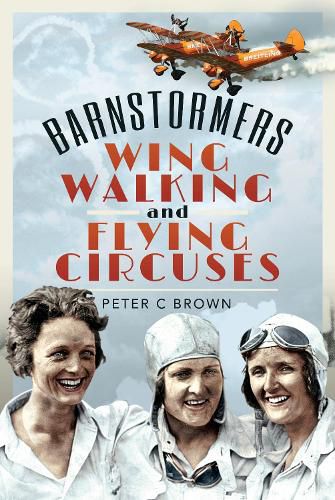Readings Newsletter
Become a Readings Member to make your shopping experience even easier.
Sign in or sign up for free!
You’re not far away from qualifying for FREE standard shipping within Australia
You’ve qualified for FREE standard shipping within Australia
The cart is loading…






While large numbers of aeroplanes had been produced In America for the war effort overseas at the Western Front, it was found that that the British, French and Germans were far ahead of them when it came to flight technology, which led to a huge surplus of aeroplanes in the United States. The government’s solution to recover some of the money was to sell the surplus stock off for as little as $200 dollars each. With no licence being required to fly a plane, the offer attracted many ex-fighter pilots as well as civilians, who developed a new American pastime known as barnstorming. Part entertainers, part thrill-seekers, the barnstormers made their way across the country as solo acts and in groups called ‘Flying Circuses’. The American flier Ormer Locklear wowed the crowds by climbing out of his aeroplane and walk along the wing, and it wasn’t long before flying circuses held less appeal for spectators if it didn’t have a wing-walking act. Handstands, jumps across planes, and even the odd game of tennis were attempted by barnstormers to attract larger paying audiences. In 1936, the US Government banned wing-walking under 1,500 ft, which doomed aerial stunting, and while a few wing-walking teams operated in the 1970s, it wasn’t until barnstormer Vic Norman founded his famous AeroSuperBatics wing-walking team in the early 1980s that the sight of daredevils hand-standing and flying upside down on the wing was seen in Europe. Several teams around the world subsequently formed using aeroplanes such as the Boeing Stearman or the Curtiss ‘Jenny’ biplanes to wow crowds as a part of regular air displays, and their appeal has continued to rise since the 2000s.
AUTHOR: Peter C. Brown is a writer of local and military history. He was born in 1959, grew up in Southend-on-Sea, Essex, moving to Mablethorpe, Lincolnshire, with his wife and their cats in 2014, where he continues to write non-fiction. To date he has had sixteen books published.
50 b/w illustrations
$9.00 standard shipping within Australia
FREE standard shipping within Australia for orders over $100.00
Express & International shipping calculated at checkout
While large numbers of aeroplanes had been produced In America for the war effort overseas at the Western Front, it was found that that the British, French and Germans were far ahead of them when it came to flight technology, which led to a huge surplus of aeroplanes in the United States. The government’s solution to recover some of the money was to sell the surplus stock off for as little as $200 dollars each. With no licence being required to fly a plane, the offer attracted many ex-fighter pilots as well as civilians, who developed a new American pastime known as barnstorming. Part entertainers, part thrill-seekers, the barnstormers made their way across the country as solo acts and in groups called ‘Flying Circuses’. The American flier Ormer Locklear wowed the crowds by climbing out of his aeroplane and walk along the wing, and it wasn’t long before flying circuses held less appeal for spectators if it didn’t have a wing-walking act. Handstands, jumps across planes, and even the odd game of tennis were attempted by barnstormers to attract larger paying audiences. In 1936, the US Government banned wing-walking under 1,500 ft, which doomed aerial stunting, and while a few wing-walking teams operated in the 1970s, it wasn’t until barnstormer Vic Norman founded his famous AeroSuperBatics wing-walking team in the early 1980s that the sight of daredevils hand-standing and flying upside down on the wing was seen in Europe. Several teams around the world subsequently formed using aeroplanes such as the Boeing Stearman or the Curtiss ‘Jenny’ biplanes to wow crowds as a part of regular air displays, and their appeal has continued to rise since the 2000s.
AUTHOR: Peter C. Brown is a writer of local and military history. He was born in 1959, grew up in Southend-on-Sea, Essex, moving to Mablethorpe, Lincolnshire, with his wife and their cats in 2014, where he continues to write non-fiction. To date he has had sixteen books published.
50 b/w illustrations